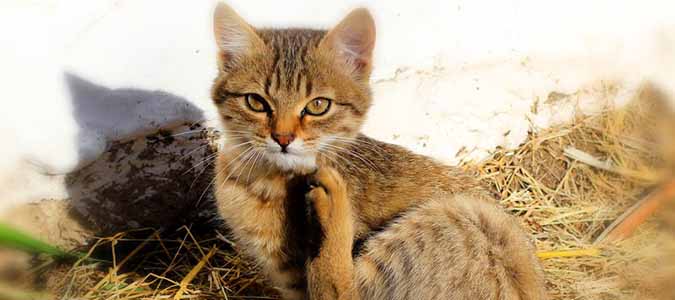
All pet owners know that fleas are a never-ending problem in warm climates. As soon as warm weather returns to San Antonio, fleas reappear with a vengeance, turning your cute pets into scratching machines.
As common as they are, there’s no simple solution to fleas. To successfully eliminate them in your home, you must simultaneously treat your house, your pets, and your yard. With effective treatment, you can kill adult fleas and remove their eggs, disrupting the flea reproductive cycle.
Below we’ll take a look at the problem and offer some solutions that will help you deal with flea infestations in your home.
Why are fleas a problem?
Fleas feed on blood. Their bites cause pets (and when populations are high, their human family) to suffer significant itchiness. In some cases, pets become allergic to the flea bites, causing dermatitis, scaly skin, hot spots, and skin infections.
When cats lick themselves to wash, they can ingest fleas that transmit tapeworms internally.
Reducing fleas in the yard
The first step in successfully treating fleas is reducing opportunities for pets to pick them up from the yard. Here are a few suggestions to help control fleas outdoors.
- In early spring, treat your landscape with beneficial nematodes. They need cooler temperatures and moist conditions, so by the height of summer (and flea season), it’s too late to apply them.
- Keep your lawn mowed, reducing areas for fleas to breed and come in contact with your pets.
- Discourage wildlife and stray animals from coming into your yard, as they are a primary vector of fleas. Repair fences and don’t feed squirrels, deer or other wildlife.
- Sprinkle outdoor pet areas with diatomaceous earth and reapply after rain.
- Use natural insect repellent plants in your landscape, such as lemongrass, catnip, scented geraniums, and rosemary.
- Try natural, eco-friendly perimeter sprays that contain cedar oil or other natural pest control ingredients.
Treating your home for fleas
Once your pets have acquired fleas, you need to treat the entire home, particularly areas where your pets sleep or play. To get a head start, there are premise sprays, foggers, and various kinds of dusts you can use to treat your home.
For ongoing flea control in the home:
- Vacuum your carpets and floors, which removes flea eggs and “flea dirt”, the dried blood that comes from fleas and which feeds their larvae.
- Regularly launder all pet bedding.
- Treat cat trees and other areas cats like to sleep with non-toxic flea sprays.
- Don’t forget to wash/treat furniture and human bedding, which are also places where flea eggs can hide.
Pet flea control that works
Sometimes no matter how hard you try to prevent it, you will still find fleas on Fluffy and Fido.
Use prescription flea control (both oral and topical) for cats and dogs from your vet. Be aware that some products work better than others. In many areas of Texas, for example, fleas have become immune to Frontline.
Bathe all pets with non-toxic flea shampoos (including blue Dawn dishwasher detergent, which is highly effective), leaving the suds on for several minutes to kill all of the fleas before rinsing it off.
Try non-toxic flea sprays made from cedar oil, such as Wondercide. These sprays kill fleas on contact. These are particularly great options for puppies, kittens, and cats who hate bath time. You can also make your own (for dogs only) with a blend of a half cup of apple cider vinegar, two cups of water and two drops of cedar oil.
Dust pets with non-toxic diatomaceous earth, making sure to work the material deep into the fur. Take care not to stir up too much dust, which can be irritating to the lungs in both you and your pets.
For cats and short-haired dogs, invest in a good flea comb and regularly comb your pets. Drop captured fleas into a cup of water to which you’ve added a few drops of dish or hand soap to kill them on contact. With consistent effort, this alone can significantly reduce the flea population.
There are fabric collars for dogs that allow you to add small amounts of safe essential oils such as cedar or lavender oil that serve as flea repellents. These are not advisable for cats, for which essential oils are frequently dangerous.
One caution: be very careful when choosing over-the-counter flea treatments. Many topical products mimic the form of prescription medications, but these can be very toxic to pets—particularly older pets, puppies and kittens, and pets with health issues.
Meanwhile, many national brands of flea collars contain highly toxic pesticides, including tetrachlorvinphos and propoxur, which can cause nerve damage, and can be especially harmful to children who come into contact with these collars. Because of these hazards, we strongly recommend you talk to your vet before choosing over-the-counter solutions for flea treatments that involve any kinds of pesticides.
Had enough of fleas?

Dealing with fleas can feel like fighting a neverending war. The only flea we have any real appreciation for is this guy above!
If the bad fleas have gotten the best of you and your pets, it’s time to give ABC Home and Commercial Services San Antonio a call. We can come out and treat flea infestations in your home and yard, and offer additional suggestions on how to safely treat your four-legged friends.